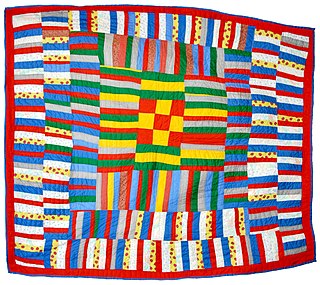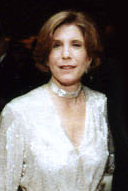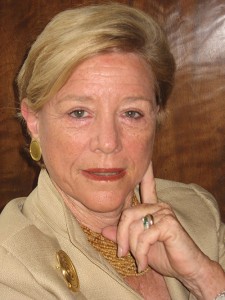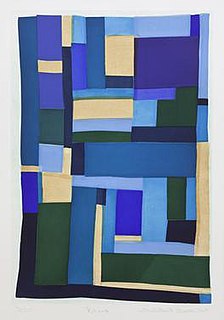
Walter Hubert Annenberg was an American businessman, investor, philanthropist, and diplomat. Annenberg owned and operated Triangle Publications, which included ownership of The Philadelphia Inquirer, TV Guide, the Daily Racing Form and Seventeen magazine. He was appointed by President Richard Nixon as United States Ambassador to the United Kingdom, where he served from 1969 to 1974.

Ellsworth Kelly was an American painter, sculptor, and printmaker associated with hard-edge painting, Color Field painting and minimalism. His works demonstrate unassuming techniques emphasizing line, color and form, similar to the work of John McLaughlin and Kenneth Noland. Kelly often employed bright colors. He lived and worked in Spencertown, New York.
The Eisenhower Medical Center (EMC) is a not-for-profit hospital based in Rancho Mirage, California serving the Coachella Valley region of Southeastern California. It was named one of the top one hundred hospitals in the United States in 2005.
The Annenberg Foundation is a family foundation that provides funding and support to non-profit organizations in the United States and around the world. Some of the Foundation's core initiatives are the Annenberg/Corporation for Public Broadcasting (CPB) project, which funds many educational television shows broadcast on Public Broadcasting Service (PBS) public television in the United States as well as The Annenberg Community Beach House, The Annenberg Space for Photography, Metabolic Studio, explore.org, Wallis Annenberg PetSpace and the Wallis Annenberg Center for Performing Arts.
The American Academy of Diplomacy is a private, nonprofit, non-partisan, elected organization whose active membership is limited to men and women who have held positions of high responsibility in crafting and implementing American foreign policy. They have served the United States as chiefs of mission in major embassies abroad, and/or equivalent high-level foreign policy positions in Washington.

The quilts of Gee's Bend are quilts created by a group of women and their ancestors who live or have lived in the isolated African-American hamlet of Gee's Bend, Alabama along the Alabama River. The quilts of Gee's Bend are among the most important African-American visual and cultural contributions to the history of art within the United States. Arlonzia Pettway, Annie Mae Young and Mary Lee Bendolph are among some of the most notable quilters from Gee's Bend. Many of the residents in the community can trace their ancestry back to enslaved people from the Pettway Plantation. Arlonzia Pettway can recall her grandmother's stories of her ancestors, specifically of Dinah Miller, who was brought to the United States by slave ship in 1859.

Leonore Cohn Annenberg, also known as Lee Annenberg, was an American businesswoman, diplomat, and philanthropist. She was noted for serving as Chief of Protocol of the United States from 1981 to 1982. Annenberg was married to Walter Annenberg, who was an Ambassador to the United Kingdom and newspaper publisher. She also served as the chairman and president of the Annenberg Foundation from 2002 until 2009.
Art in Embassies, an office within the U.S. Department of State, promotes cultural diplomacy through exhibitions, permanent collections, site-specific commissions and two-way artist exchanges in more than 200 U.S. Embassies and Consulates around the world. Through art, international audiences gain a sense of the quality, scope, and diversity of American and host country art and culture. Initiated by President Kennedy in 1963, the program is funded by the U.S. Department of State.

Sunnylands, the former Annenberg Estate, located in Rancho Mirage, California, is a 200-acre (0.81 km2) estate currently run by The Annenberg Foundation Trust at Sunnylands, a not-for-profit organization. The property was owned by Walter and Leonore Annenberg until 2009 and had been used as a winter retreat by the couple beginning in 1966, when the house was completed. The city of Rancho Mirage considers the property to be “rich with historical significance” and declared Sunnylands an historic site in 1990. Located at Frank Sinatra and Bob Hope Drives, the property has been the vacation site of numerous celebrities and public officials. Sunnylands is sometimes referred to as the "Camp David of the West."

Wallis Huberta Annenberg is an American philanthropist and heiress. Annenberg serves as president and chairwoman of the Board of The Annenberg Foundation, a multibillion-dollar philanthropic organization in the United States.

Wendy W. Luers is the founder and president of The Foundation for a Civil Society, a democratization and non-profit organization.

Barbara Ernst Prey is an American artist who specializes in the art of watercolor. In 2008 Prey was appointed to the National Council on the Arts, the advisory body of the National Endowment for the Arts. In 2015, MASS MoCA commissioned Barbara Prey to create the world’s largest known watercolor painting for its new Building 6, which opened in Spring 2017. She has worked in oil painting and illustration, the latter of which she contributed to The New Yorker for a decade. She currently works and lives in Long Island, New York, Maine and Williamstown, Massachusetts.
Paul J. Smith was an arts administrator, curator, and artist based in New York. Smith was professionally involved with the art, craft, and design fields since the early 1950s and was closely associated with the twentieth-century studio craft movement in the United States. He joined the staff of the American Craftsmen's Council in 1957, and in 1963 was appointed Director of the Museum of Contemporary Crafts, a position he held for the next 24 years. In September 1987, he assumed the title of director emeritus and continued to work as an independent curator and consultant for museums, arts organizations, and collectors.
Louisiana Bendolph is an American visual artist and quilt maker. Bendolph is associated with The Quilts of Gee's Bend and her work has been considered more conceptual because of her use of vibrant color.

Mary Lee Bendolph is an American quilt maker of the Gee's Bend Collective from Gee's Bend (Boykin), Alabama. Her work has been influential on subsequent quilters and artists and her quilts have been exhibited in museums and galleries around the country. Bendolph uses fabric from used clothing for quilting in appreciation of the "love and spirit" with old cloth. Bendolph has spent her life in Gee's Bend and has had work featured in the Philadelphia Museum of Art as well as the Minneapolis Institute of Art in Minnesota.

Blues is a 2007 print by Gee's Bend quilter Loretta Pettway Bennett located on the Eskenazi Health campus, near downtown Indianapolis, Indiana, and is part of the Eskenazi Health Art Collection.

Forever is a 2006 print by Gee's Bend quilter Loretta Pettway Bennett located on the Eskenazi Health campus, near downtown Indianapolis, Indiana, and is part of the Eskenazi Health Art Collection.

Sew Low is a 2011-2012 quilt by Gee's Bend quilter Loretta Pettway Bennett. It is located on the Eskenazi Health campus, near downtown Indianapolis, Indiana, and is part of the Eskenazi Health Art Collection.

Vegetation is a 2009 quilt by Gee's Bend quilter Loretta Pettway Bennett. It is located on the Eskenazi Health campus, near downtown Indianapolis, Indiana, and is part of the Eskenazi Health Art Collection.
Julia Bullock is an American soprano originally from St. Louis, Missouri. Anthony Tommasini from The New York Times has called her an "impressive, fast-rising soprano... poised for a significant career”.














